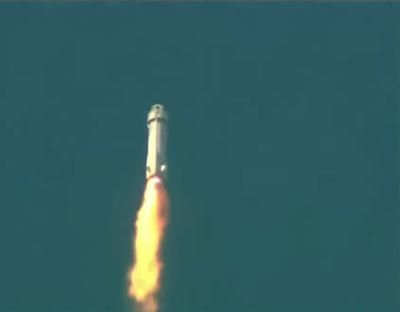"Anomaly" During NS-23 Launch Tests Bounds of Capsule Escape System
Blue Origin viewers got a little bit of excitement during the broadcast today, as the uncrewed NS-23 launch ended with some dramatic flare as the crew capsule apparently aborted the launch and departed the booster.

Viewers of the livestreamed launch saw NS-23 ascend to a height of about 30,000 feet before spying an unexpected spurt of flames from the New Shepard crew capsule. The capsule appeared to ignite its rocket-powered escape system just over a minute after launch, separating far sooner than would be proper for a successful journey to the Karman line. The capsule ascended to its apogee of 37,000 feet before releasing its drogues as it came back down to Earth. Blue Origin's announcer had little to say regarding the incident, aside from acknowledging that an anomaly had occurred as audiences watched the capsule descend in awkward silence.
The descent appeared to have been successful, with each successive stage of parachutes slowing it down before touching down in a cloud of dust. The announcer stated that the capsule's retro thrust system would fire in the final moments before touchdown. Perhaps primed for failure, some audience imagined that those systems had failed, too given what appeared to be a firm impact and lack of flames they imagined would be present for the retro thrust system. In actuality, the New Shepard does not rely upon traditional rockets for retro thrust, instead using a compressed air system for its final deceleration. The capsule's landing was obscured in part by the large dust cloud formed from the retro thruster, and can be assumed to have provided the ideal touchdown speed of 1 mph.

The company described the incident shortly afterwards as proof positive of their safety system's functionality despite the overall mission failure. In a tersely worded tweet, Blue Origin said the capsule's "escape system performed as designed" in allowing the Capsule to separate from the booster. The booster, however, likely did not survive its trip back down to Earth. The forces involved in a possibly uncontrolled tumble from 30,000 feet likely far exceed its capability, but more details remain to be seen. Currently, all that is known was that the "booster impacted the ground," with "no reported injuries."

NS-23 was an uncrewed developmental flight of sorts, likely intended to stress test Blue Origin systems while carrying non-essential materials on board for a short trip through space before coming back down. Both the New Shepard capsule and booster were veterans of the Blue Origin flight program with 9 launches under their belts. Most of its cargo consisted of projects, souvenirs, experiments, and the like created with a variety of K-12 educational bodies, universities, and STEM booster groups. Some experiments, like University of Florida's plant analysis project, were frequent fliers with the New Shepard program. Blue Origin's Club for the Future membership also lent their efforts in providing thousands of postcards, a common launch tradition at the company.
Blue Origin will announce further details at a later time.
 Sierra Space Repositions Dream Chaser for First Mission
Sierra Space Repositions Dream Chaser for First Mission ANN's Daily Aero-Term (05.10.24): Takeoff Roll
ANN's Daily Aero-Term (05.10.24): Takeoff Roll Aero-News: Quote of the Day (05.10.24)
Aero-News: Quote of the Day (05.10.24) Aero-News: Quote of the Day (05.11.24)
Aero-News: Quote of the Day (05.11.24) ANN's Daily Aero-Term (05.11.24): IDENT Feature
ANN's Daily Aero-Term (05.11.24): IDENT Feature




